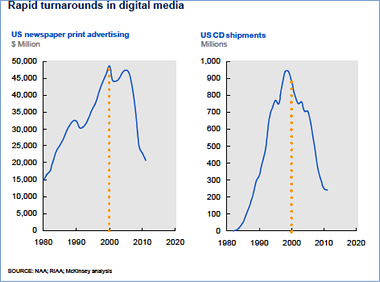CEO Blog - Advice for CEOs on growth and scaling
6 Steps to Understanding and Adapting to the Contours of Change


Markets, like the companies and people who participate in them, are constantly evolving. Many an organization has seen its growth derailed or even faced its demise for failing to pick up or act on a key evolution in their market. The news about the sale of the Washington Post to Amazon founder Jeff Bezos brought that point back to center stage.
Listening to Jeff in an interview talk about his commitment to journalism and the news, reminded me of the impact he had on booksellers like Borders, Barnes and Noble and eventually on concepts of retail itself. More than a decade ago, I spoke at a Gartner conference about the changes that Amazon’s approach would have on books, video and other media. In the audience that day was an executive from Blockbuster who loudly refuted my assertion that digital would change everything.
Today it’s clear to see how Blockbuster’s failure to understand and adapt to the coming changes eventually led to its demise. But when you’re in the moment, it’s not always so easy to see the danger ahead or to the side.
Perhaps there are blinders born of your success or simply certainty about what to do next. If that were not the case, there would not be so many examples of companies who have been or are in the process of being left behind. Sometimes those left behind are the very companies who created new markets that left others behind. Consider Kodak who failed to catch the shift that its own invention of digital cameras created or the leading manufacturers of personal computers now facing a major shift to tablet and smartphones.
All of these examples share a history of success that made them household names. They also happen to have been impacted by advances in digital technology and media to which they failed to adapt quickly enough. No matter what market you are in, there is some analogous change happening below the surface that may pose a future threat.
To illustrate this, permit me to continue with my media examples. This week’s announcement about the sale of the Washington Post highlights the shift in how people consume news and its impact on traditional newspaper businesses. In a recent McKinsey article on the iConsumer, this was dramatically illustrated via the following chart.

At some point, all of these shifts were clear and yet many companies, large and small, missed the early warning signs or interpreted them too late. McKinsey’s report outlines six shifts in consumer behavior that portend what lies ahead for many industries and suggests ways in which digital consumers are altering the value chain. These are shifts in devices (from PC to touch), communications (from voice to data), content (from bundled to fragmented), social (from growth to monetization), video (from programmer to user-controlled) and retail (from channel to experience).
How might your value chain be altered by these shifts? For leaders focused on managing day-to-day operations, it’s often difficult to see the shifts early on. This can be an even greater challenge for CEOs of small to mid-sized companies who may be even more consumed by the daily operations.
Today digitally savvy consumers are having a profound impact on nearly every market sector. Whether you are making a household product or providing a service, you will eventually be impacted. So how do you monitor the pulse of change in your industry and prepare to shift with it? Taking the following six steps will help you develop the agility your business will need to understand and adapt to the contours of change.
FIRST, if you do not already have a clear process for listening to the voice of your customers, make putting one in place a priority. Digital tools available to support gathering insights include social media, formal surveys and a multitude of feedback forums. Capture the intelligence from your sales, marketing, product and service teams via CRM and other processes to provide additional perspective.
SECOND, get good at analyzing this data and what you already capture about your customers. What do they buy, how often and how do they buy, who are the most valuable and what characterizes them? You may need to bring in some new tools or skills to help you. This is something that you can initially outsource while you learn what you may need to do yourself. Build testing into your processes to learn quickly before making key changes in products/services, pricing, marketing or business practices.
THIRD, look deeper at the behaviors and trends behind the data. How might buying patterns be changing? Are different types of buyers emerging and how are they different? Is the buying process itself changing? Will your sales, marketing and service processes support the changing buying process?
While both steps two and three emphasize analysis, they also highlight the need to test, to try new things and learn from them. Jeff Bezos emphasized the same in a statement about his acquisition of the Post and the other Graham family newspapers where he wrote: "The Internet is transforming almost every element of the news business: shortening news cycles, eroding long-reliable revenue sources, and enabling new kinds of competition, some of which bear little or no news-gathering costs. There is no map, and charting a path ahead will not be easy. We will need to invent, which means we will need to experiment."
FOURTH, share customer and market insights widely and transparently across the business and encourage conversations about them. Everyone in the company has a role in delivering what the customer needs, when, where and how they need it. Find vehicles such as lunch and learns, all-hand briefings, news flashes, etc. that works that work within your culture to inform and align the organization.
FIFTH, set aside some time each month to work on something outside the norm.
This can be as simple as giving everyone a half-day a month to work on something new and report back on what they learned in the process. The result may be gems of insight or ideas that help your business adapt and thrive.
SIX, nurture and publicly reward both those who contribute good ideas and those who make them a reality. All of these steps are part of cultivating a “healthy business lifestyle” that exercises good listening, good analysis, testing to learn, transparency and execution. Taking these steps will help you maintain the agility to anticipate and adapt to the inevitable changes that lie ahead.
Change is often uncomfortable, but the absence of change can be even more so since it can mean stagnation and even possibly death. It also takes time to think about and address change. Finding that time can be a challenge for CEOs and their leadership team. CEOs often bring us in to help them see, understand and plan for the changes that may hamper the achievement of their vision.
Topics: Business Growth Strategy, B2B Marketing
Wed, Aug 14, 2013- Press Releases
- Careers
- Case Studies
- Marketing Consultant Company
- Marketing Strategy Consultants
- Marketing Plan Consultants
- B2B Marketing Consultants
- Virtual CMO
- Marketing Consultant Outsourcing
- Fractional CMO
- What is a Fractional CMO
- Healthcare Marketing Consultant
- Marketing Consultant Houston TX Texas
- Marketing Consultant Texas TX
- Marketing Consultant Bay Area
- CEO Blog
- Ebooks Plus
- Executive Marketing Consultants
- Product Marketing Consultants
- B2C Marketing Consultants
- Virtual Marketing Consultants
- Senior Marketing Consultants
- Temporary CMO
- Hire a CMO
- Fractional CMO Salary
- Fractional CMO Responsibilities
- Marketing Consultant Austin TX Texas
- Marketing Consultant Dallas TX Texas
- Marketing Consultant San Antonio
- Helping Private Equity
- Private Equity Blog
- Leadership Team
- Privacy Policy
- Business Marketing Consultants
- Strategic Marketing Consultants
- Marketing Technology Consultants
- Sales and Marketing Consultants
- CMO Job Description
- CMO Salary
- Fractional CMO Agency
- Fractional CMO Services
- CPG Marketing Consultant
- Marketing Consultant San Diego
- Partners
Houston, TX 77056
© 2023 Chief Outsiders


